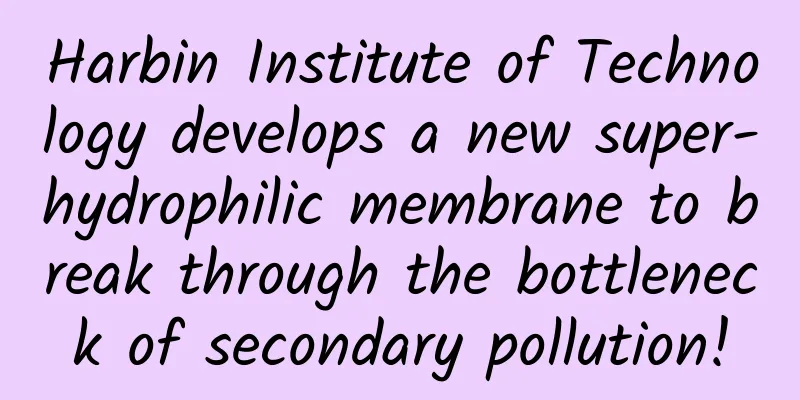Harbin Institute of Technology develops a new super-hydrophilic membrane to break through the bottleneck of secondary pollution!

|
Science and Technology Daily (Reporter Li Liyun, Correspondent Zhang Yuqin) On September 10, the reporter learned from Harbin Institute of Technology that the team of Academician Ma Jun from the Sino-European Membrane Technology Research Institute of the School of Marine Science and Technology at the Weihai Campus of the university has obtained a biodegradable super-hydrophilic nanofiber oil-water separation membrane through electrospinning technology, breaking through the bottleneck of secondary pollution after the traditional polymer separation membrane is discarded . The results were recently published in the journal Science Advances. Industrial oily wastewater discharge poses a major threat to ecosystems and human health, and seriously damages the global water-food-energy chain. At present, oil-water separation mainly relies on super-hydrophilic organic polymer materials to form a hydration layer on the surface of the material to prevent oil from passing through. However, in existing oil-water separation membranes, super-hydrophilic membrane materials are mostly derived from fossil resources, and membrane waste is often disposed of by landfill or incineration. Improper management will produce secondary pollution such as microplastics, which is not conducive to the sustainable development of the ecological environment. In this study, the team used the strategy of electrospinning of biodegradable super-hydrophilic membranes to prepare environmentally friendly super-hydrophilic polylactic acid nanofiber membranes. "This strategy allows polylactic acid and polyethylene oxide hydrogel to form a cross-linked structure. By controlling the electrospinning parameters and designing an asymmetric structure, a high permeability flux, high separation efficiency and biodegradable super-hydrophilic polylactic acid nanofiber membrane is obtained. The separation efficiency of this membrane exceeds 99.6%." Cheng Xiquan, the first author of the paper and a distinguished professor at the School of Marine Science and Technology, Weihai Campus of Harbin Institute of Technology, told reporters that this kind of membrane has stable performance under the conditions of use and can be biodegraded within 1 week after being treated with proteinase K, providing a new way for green and low-carbon development for the preparation of polymer oil-water separation membranes. It is reported that the preparation strategy of this membrane provides a universal hydrophilic modification method for the new generation of high-performance polymer matrix membranes, and at the same time provides forward-looking technical support for the efficient and rapid separation and purification of oily wastewater. |
>>: Tiansheng Bridge, the coolest bridge built by nature
Recommend
The efficacy and function of Fern
Traditional Chinese medicine often has unexpected...
The efficacy and function of horn-winged euonymus
Do you know Euonymus japonicus? It is a common Ch...
The efficacy and function of white-backed poplar
White-backed poplar is a relatively familiar trad...
The efficacy and function of Dunsheng grass
As people's living standards improve, they pa...
Spring Festival stomach protection war: eat well and drink well without hurting your stomach, remember these points
The battle to protect your stomach during the Spr...
What are the medicinal materials for making wine to strengthen yang and nourish kidney?
Nowadays, people pay more and more attention to h...
If this group of people are infected with influenza, use cough suppressants with caution! Symptoms may be masked
The year just passed There has been a lot of news...
Are allergies caused by low immunity? Let us tell you the truth about allergies
Can not taking a shower prevent skin allergies? F...
If your eyes suddenly go dark, it may be a sign of blindness due to a stroke! The best rescue time is only 1.5 hours...
You must be tired after studying and working all ...
In late autumn, if you want to "rest", you must know these →
Recently, many places in Beijing, which has enter...
Why do vinegar and baking soda clean stains?
I don't know when the seasonings on the kitch...
Did the Mesozoic era also have a "Pompeii"? Hello! Ancient "friends" under the ash of Jehol volcano
Science Times reporter epic In the northern Hebei...
[Smart Farmers] A "iron watermelon" grows on a gourd tree! How powerful is this "all-rounder" in the plant world?
Your browser does not support the video tag Calab...
Is it true that the more you eat these foods, the darker your skin will be?
Author: Xue Qingxin, one of the first nutrition i...









